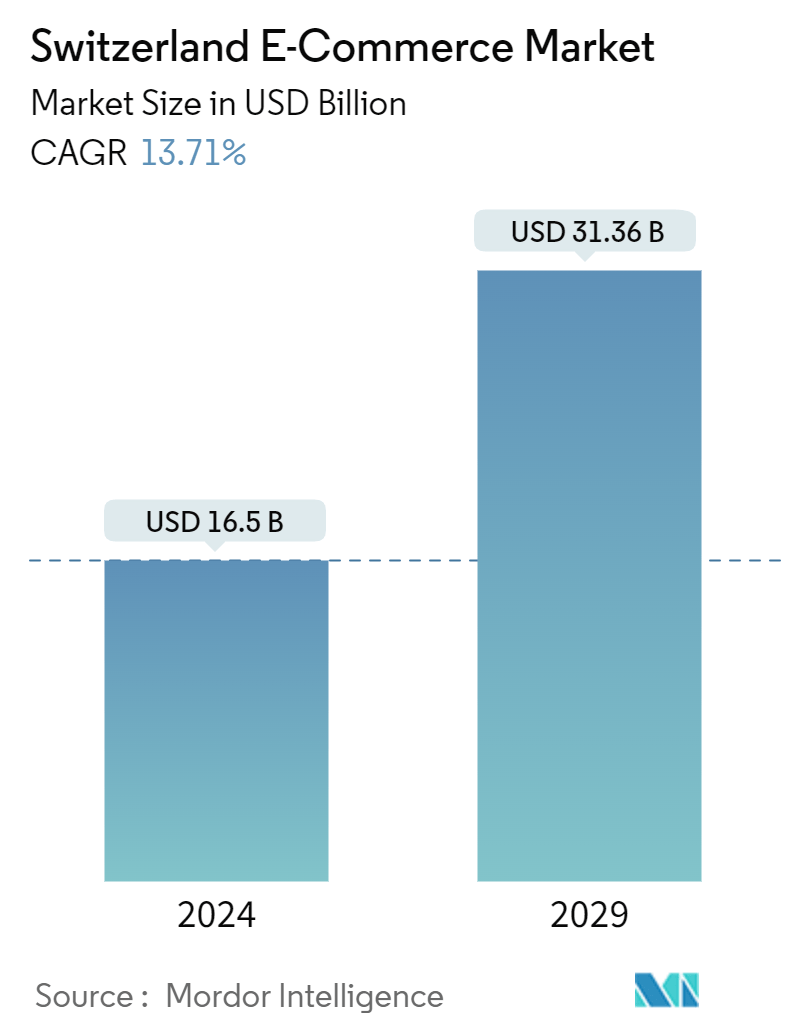| Study Period | 2019 - 2029 |
| Base Year For Estimation | 2023 |
| Forecast Data Period | 2024 - 2029 |
| Market Size (2024) | USD 16.5 Billion |
| Market Size (2029) | USD 31.36 Billion |
| CAGR (2024 - 2029) | 13.71 % |
| Market Concentration | Low |
Major Players*Disclaimer: Major Players sorted in no particular order |
E-commerce in Switzerland Market Analysis
The Switzerland E-Commerce Market size is estimated at USD 16.5 billion in 2024, and is expected to reach USD 31.36 billion by 2029, growing at a CAGR of 13.71% during the forecast period (2024-2029).
The Switzerland e-commerce market has experienced notable growth in recent years, driven by technological advancements and changing consumer preferences. This expansion is largely attributed to high internet penetration and smartphone usage, which has reshaped how Swiss consumers and businesses engage in online transactions. Both the business-to-consumer (B2C) and business-to-business (B2B) sectors have flourished, benefiting from Switzerland's affluent population and a strong preference for convenience. These factors have made the country a focal point for e-commerce development, attracting domestic and international players alike.
- However, the evolution of the market is not without challenges. Regulatory complexities, such as evolving taxation and customs regulations, pose significant hurdles, especially for cross-border transactions. Additionally, the initial costs for businesses to adopt digital commerce solutions can be a barrier, particularly for smaller enterprises. Despite these challenges, the overall outlook for Switzerland’s e-commerce market remains promising, thanks to continued technological innovations and a growing demand for online services.
Widespread Internet and Smartphone Usage Driving E-Commerce
- High Internet Penetration: Switzerland boasts one of the highest internet penetration rates globally, with 98.4% of the population having access as of 2023. This digital infrastructure has been pivotal in driving the growth of online shopping, as consumers increasingly rely on e-commerce platforms for their purchases.
- Mobile Commerce Growth: The ubiquity of smartphones has accelerated the adoption of mobile commerce (m-commerce) in Switzerland. Consumers are using their mobile devices to shop across various categories, from fashion to electronics, with significant growth noted in these sectors. Mobile commerce offers unparalleled convenience, enabling Swiss consumers to browse and purchase products on the go.
- Consumer Behavior: Swiss consumers are known for their tech-savviness, and their shopping habits reflect this. They prefer e-commerce platforms that offer multiple payment methods such as credit cards, mobile wallets, and installment options, which provide a seamless checkout experience. This adaptability has made the Swiss online retail market highly dynamic.
- Logistics and Infrastructure: To support the growing demand for e-commerce, Swiss companies are heavily investing in efficient logistics systems. Switzerland e-commerce logistics are critical to ensuring fast and reliable deliveries, which are key to maintaining consumer satisfaction.
Cross-Border E-Commerce Transactions
- Cross-Border Demand: Switzerland's geographic location and high-income consumer base make it a hub for cross-border e-commerce. Swiss consumers frequently purchase products from neighboring countries, taking advantage of the country’s advanced logistics and favorable trade agreements. This demand is especially strong in niche markets, such as specialty foods and luxury goods, which may not be readily available domestically.
- Regulatory Challenges: While cross-border transactions are flourishing, they are not without complications. Swiss e-commerce regulations, particularly customs duties and the evolving taxation landscape, create obstacles that businesses must navigate. Ensuring compliance with these regulations is crucial for companies looking to expand their cross-border presence.
- Market Impact: Cross-border e-commerce significantly contributes to Switzerland's e-commerce sales statistics, reflecting its importance to the overall market. Companies that can streamline their operations and comply with regulatory requirements will be well-positioned to capitalize on this growing trend.
E-commerce in Switzerland Industry Segmentation
The internet trade of goods and services is known as e-commerce (or electronic commerce). These commercial dealings are either B2B (business-to-business), B2C (business-to-consumer), or C2C (consumer-to-consumer). A more recent business model is known as "direct-to-consumer" (D2C), allowing brands to sell directly to consumers. The internet is what drives e-commerce. Consumers use their devices to access an online store to browse the selection and place orders for goods or services.
The Switzerland E-Commerce Market is Segmented by B2C E-Commerce (by application [beauty & personal care, consumer electronics, fashion & beverage, furniture & home, others (toys, DIY, media, etc.]]) and by B2B E-Commerce. The report offers market forecasts and size in value (USD) for all the above segments.
| Application | Beauty & Personal Care |
| Consumer Electronics | |
| Fashion & Apparel | |
| Food & Beverage | |
| Furniture & Home | |
| Others (Toys, DIY, Media, etc.) |
| Market Size for the Study Period |
Switzerland E-Commerce Market Size Summary
The e-commerce market in Switzerland is experiencing significant growth, driven by high internet penetration and a strong inclination towards online shopping among the population. The country's strategic position in Europe, with favorable tax regimes and custom policies, makes it an attractive destination for cross-border investments. The Swiss market is characterized by a competitive landscape with major players like ZurRose Group, Nespresso, and Digitec Galaxus AG leading the charge. The pandemic has accelerated digitalization, prompting businesses to invest in advanced technologies such as AI and IoT to enhance their operational efficiency and customer experience. Initiatives like the QR bill and autonomous delivery services are examples of how Switzerland is embracing digital transformation to streamline financial processes and logistics.
Consumer preferences in Switzerland are shifting towards healthier and more sustainable options, as seen in the rise of private labels and eco-friendly products. The government's push for reduced sugar consumption has influenced product offerings, with companies committing to healthier alternatives. The e-commerce sector is also witnessing innovations like compostable packaging and adaptive fashion, catering to diverse consumer needs. Retailers are focusing on enhancing their online presence and customer engagement through omnichannel strategies and personalized offerings. As the market continues to evolve, the integration of automation and smart technologies is expected to play a crucial role in meeting the growing demand for convenience and efficiency in online shopping.
Switzerland E-Commerce Market Size - Table of Contents
1. MARKET DYNAMICS
-
1.1 Market Drivers
- 1.1.1 High Dependency for Booking of Hotels and Flights
- 1.1.2 Penetration of Internet and Smartphone Usage
-
1.2 Market Restraints
- 1.2.1 Evolving Taxation Landscape and Custom Regulations has Increased the Complexity of Trade
- 1.2.2 Digitization of e-commerce may Incur Expenses for Consumers
2. MARKET SEGMENTATION
-
2.1 By B2C ecommerce
- 2.1.1 Application
- 2.1.1.1 Beauty & Personal Care
- 2.1.1.2 Consumer Electronics
- 2.1.1.3 Fashion & Apparel
- 2.1.1.4 Food & Beverage
- 2.1.1.5 Furniture & Home
- 2.1.1.6 Others (Toys, DIY, Media, etc.)
-
2.2 By B2B ecommerce
- 2.2.1 Market Size for the Study Period
E-commerce in Switzerland Market Research FAQs
How big is the Switzerland E-Commerce Market?
The Switzerland E-Commerce Market size is expected to reach USD 18.76 billion in 2025 and grow at a CAGR of 13.71% to reach USD 35.67 billion by 2030.
What is the current Switzerland E-Commerce Market size?
In 2025, the Switzerland E-Commerce Market size is expected to reach USD 18.76 billion.




